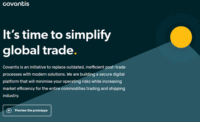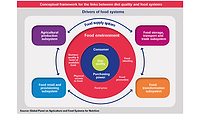Manufacturing News
Regenerative agriculture initiative seeks worldwide participation
The group supports agribusinesses in transitioning to practices that increase soil health, enhance biodiversity, sequester carbon and improve water management

The regenagri Digital Hub offers a set of tools and analytics to support agribusinesses to transition to regenerative systems.
Photo courtesy of Pixabay
The new governance team member organizations bring together vast knowledge and expertise across the regenagri program’s pillars in implementing regenerative agricultural systems and include:
- Soil Association (www.soilassociation.org)
- Sustainable Food Trust (www.sustainablefoodtrust.org)
- Farming and Wildlife Advisory Group (FWAG) (www.fwag.org.uk)
- Cool Farm Alliance (www.coolfarmtool.org)
- Agrimetrics (www.agrimetrics.co.uk)
- Control Union (www.petersoncontrolunion.com/en)
“We’re very proud to be part of such a knowledgeable group developing the regenagri initiative further,” says Franco Costantini, managing director at Control Union UK. “Collaboration is key in supporting the agricultural sector to unlock the benefits of regenerative systems.”
Control Union is an independent certification and inspection body, supporting businesses to define, measure and achieve their sustainability goals.
FE spoke with Harry Farnsworth, sustainable agriculture projects lead at Control Union UK, who leads the regenagri initiative.
FE: Is regenagri primarily a UK or European effort? Is it looking for worldwide participation? Is anyone so far participating from the USA?
Farnsworth: Regenagri was developed and launched in the UK but we’re rolling the initiative out internationally, leveraging on Control Union’s global presence. We’re aiming for regenagri to be a globally adopted initiative. And although we don’t currently have any projects in the USA, we’re discussing opportunities with agribusinesses based there.
FE: Are you looking for small, medium or large corporate farms to participate?
Farnsworth: Although we’re currently mainly working with medium-large sized enterprises, regenagri is open to all agribusinesses. It’s also open to the wider agricultural supply chain, not just farm businesses.
FE: Are the six governance members founding members? Do you expect any governments to participate, e.g., the U.S. Department of Agriculture?
Farnsworth: The regenagri governance group is partners joining together to develop regenagri further. They all have specialist knowledge in the key pillars of regenagri: soil health, carbon sequestration, water quality and biodiversity. Over the coming months, we hope to have conversations with government stakeholders, as much of regenagri’s aims and objectives are aligned to government plans and incentives.
FE: Is the Digital Hub a way to bring members together? What does it offer to members? Does regenagri play any role in the farm-to-fork food supply chain?
Farnsworth: The Digital Hub houses a set of tools and analytics to support agribusinesses to transition to regenerative systems. It’s where members can measure on-farm practices against the regenagri criteria—to benchmark and track performance.
We also offer certification, which will apply to the entire supply chain and help increase the value of products from regenerative sources. The initiative supports the transition to regenerative systems and focuses on improving the health of the land and the wealth of those that live on it. The Digital Hub will also become an information resource for regenerative agriculture for regenagri members.
FE: What tools does the Digital Hub provide, and how do they work?
Farnsworth: The regenagri Digital Hub is designed for continuous improvement. It provides members with the tools to track their regenerative progress over time, and over multiple farms. Members can also measure their impact on reducing greenhouse gas emissions against key regenerative principles and benchmarking data. Through offering advice and support, we also help farms to identify areas for improvement and monitor progress.
FE: What is the cost of membership?
Farnsworth: Regenagri membership is an annual fee based on revenue, ranging from £300 upwards.
For more information, visit https://regenagri.org
Looking for a reprint of this article?
From high-res PDFs to custom plaques, order your copy today!







